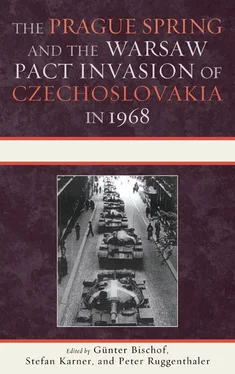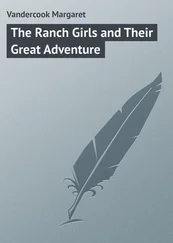UNINTENDED CONSEQUENCES: THE INVASION OF CZECHOSLOVAKIA AND THE STRENGTHENING OF THE NATO ALLIANCE 60
Ever since de Gaulle’s withdrawal of French forces from the military command of NATO in 1966, the Western alliance seemed floundering in a state of crisis. In 1967 the “Harmel Report” was published, ostensibly giving NATO a larger role in European efforts toward détente. In the midst of the growing U.S. engagement in Vietnam and the mushrooming costs of that war, tensions were further aggravated by pressure on West Germany and the NATO allies to assume more of the costs of Western defense. A reluctant West Germany agreed to buy more arms from the United States and, thus, help to assuage the U.S. balance of payment deficits with such massive “offset payments.” The resistance of NATO allies to aid the U.S. war effort in Vietnam with troops led Senate leaders to demand the withdrawal of sizable numbers of U.S. forces from Western Europe. American troop withdrawals could help save costs and remind Western Europeans that the presence of American forces on the continent never was intended to be a permanent feature of Western European defense, but only a temporary fix. 61The Warsaw Pact invasion of Czechoslovakia brought an unusual clarity to many of these contested issues of Western defense. Warsaw Pact aggression and the Brezhnev Doctrine dramatically demonstrated that Moscow was still the same wolf in sheep’s clothing. The role of NATO for the defense of Western Europe suddenly seemed more vital than ever, and the Czech crisis gave a new lease on life to NATO.
Vojtech Mastny posits that NATO’s response to the 1968 crisis “was on the whole calm, reasonable, and ultimately effective.” Harlan Cleveland, the shrewd and experienced U.S. ambassador to NATO in Brussels, recognized the repercussions of the “Czech affair” right away. With the “forward capacity” of Warsaw Pact forces on the German border of Czechoslovakia, NATO’s crisis preparedness was gravely challenged. For one, the rapid response time for NATO forces was shorter. 62Yet the Pentagon told the supreme commander, Allied Forces Europe (SACEUR) that “NATO should not regard Soviet recent military movements as directed essentially against the West.” As a consequence, in spite of the obvious change in the alert and readiness status of Soviet and Warsaw Pact forces in Eastern Europe, the SACEUR did “not put into effect any of the formal measures of military vigilance for which he has existing authority.” However, the NATO intelligence effort was intensified following the invasion. Elements of twenty-six divisions on Czechoslovak territory, Cleveland reminded Washington, represented a “military shift” that “while not evidently directed against NATO, considerably increases military uncertainties faced by NATO.” Cleveland reported from NATO Headquarters that there was “an instinctive shift to NATO” among allies. Since nobody in the West was thinking about militarily supporting Czechoslovakia, NATO could turn its gaze inward and assess the vital issues of military preparedness and alliance solidarity, as well as the alliance’s political goals. After all, NATO was never created to save the Eastern European satellites, Cleveland reminded Washington. The Warsaw Pacts destroyed with a single blow—which was militarily effective but politically counterproductive—NATO’s recent turn toward détente and the chance for mutual balanced force reductions and a final European peace order. 63
What would be the right Western diplomatic maneuver to counter the Warsaw Pact invasion of Czechoslovakia? To reenter the limelight of great power diplomacy, the French predictably pleaded for a Western summit of the United States, United Kingdom, and France. Yet it was West Germany that had been the United States’ most reliable continental ally for some time. Chancellor Kurt Georg Kiesinger pushed the idea of following the Warsaw Pact intervention with a NATO summit meeting to arrest the erosion of the troubled alliance. West German diplomats soon dismissed Kiesinger’s radio interview, in which he called for a NATO summit, as a typical “holiday talk.” Washington, however, reacted very cautiously to any suggestions for summitry, for a Western summit of any type might confirm Moscow’s propaganda line that there was a NATO and/or West German “conspiracy” afoot against Czechoslovakia and the Soviet Bloc. Any move that smacked of Western military intervention or escalation of the crisis needed to be avoided. Moscow must not be “stigmatized” in terms of the traditional Cold War context, concluded the State Department. Such caution, then, effectively meant a NATO “hands off” policy as well in response to the Warsaw Pact intervention. 64
U.S. views quickly gained a foothold to take the invasion of Czechoslovakia as a starting point for a comprehensive NATO defense review. NATO force levels and overall strategy should be thoroughly reassessed. After all, a crisis within the Eastern Bloc was something very different from a direct confrontation between NATO and the Warsaw Pact. NATO needed to rethink its entire crisis management procedures as well as the future of détente. Moreover, weapons systems, troop training, and logistics needed to be reviewed as well. Cleveland pleaded for “striking a viable transatlantic defense bargain,” namely a better mobilization of Western European reserve forces, along with a strengthening of U.S. force levels. 65Washington thus utilized the Czech crisis to place greater pressure on the Western European allies to increase their defense budgets and military posture. With plenty of hyperbole, President Johnson reminded Kurt Birrenbach, Chancellor Kiesinger’s emissary to Washington: “ While Rome is burning, the Europeans are asleep ” (emphasis mine). 66At the same time, the Czech crisis stopped all talk in Congress that called for a withdrawal of U.S. forces from Europe. At the end of September, Rusk smugly reported in a cabinet meeting that a number of critical NATO allies such as Germany and Norway had agreed to increase their defense budgets while all talk in the Senate about troop withdrawals from Europe had been stopped. Saki Dockrill is correct in noting that as far as the reinvigoration of the NATO alliance was concerned, the Czech crisis was a “blessing in disguise.” 67At the same time, bickering did not stop among the Western European allies about whether the Czech crisis showed a weakening of U.S. leadership in the alliance. Washington was called upon to show a more robust engagement with European affairs.
“The brutal disillusionment over overoptimistic interpretations of trends in détente” in Europe, was one of the principal consequences of the Czech crisis, noted Ambassador McGhee quite rightly. The presence of Soviet troops in Czechoslovakia improved the balance of power in Europe in favor of the Soviets. McGhee still advocated a pragmatic continuation of détente policies as soon as possible in order to secure the progress that had already been made. 68A basic National Security Council paper came to the same conclusions in early September when it recommended a return to détente policies “in due course.” 69President Nixon would, indeed, sign a major agreement on strategic arms limitations—also resulting from the negotiations the Johnson administration wanted to move forward in the summit of October 1968 “that never was”—as a major foreign policy initiative before his first term was over. The new German chancellor Willy Brandt had already begun pushing his ambitious Ostpolitik in 1969. Johnson never wanted a rupture in his détente policies with Moscow; thus his ambitious agenda was put on hold only temporarily. The Warsaw Pact invasion of Czechoslovakia was a very inconvenient bump on the road to détente. Secretary of State Rusk’s “hands off” policy made sure that East-West tensions would not escalate so that a return to détente would be possible. Vojtech Mastny asserts that the 1968 crisis over Czechoslovakia ironically “fostered the budding détente” since both NATO and the Warsaw Pact “at the moment of truth… both showed a prudent disposition to underestimate their own strength and overestimate the strength of the adversary.” Their 1968 crisis performance led them “to the sobering conclusion that the war they had been preparing for was wrought with so many uncertainties that it could not be planned with any reliability.” After 1968, Mastny concludes about the larger significance of the Czechoslovak crisis for Cold War strategies, “neither side courted a disaster in Europe deliberately.” 70
Читать дальше












